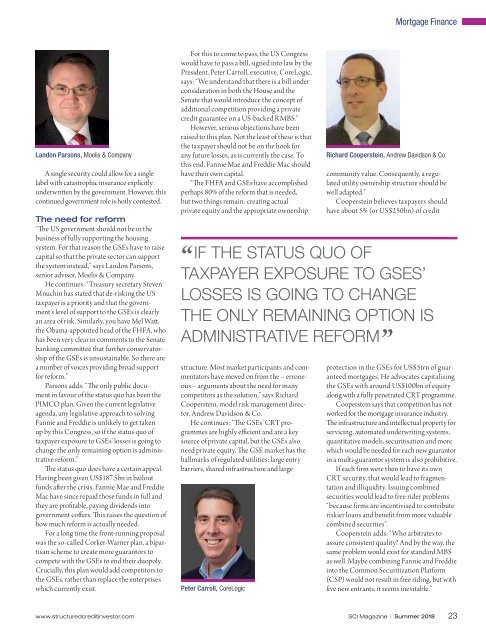SCI Magazine Summer 2018
Create successful ePaper yourself
Turn your PDF publications into a flip-book with our unique Google optimized e-Paper software.
Mortgage Finance<br />
Landon Parsons, Moelis & Company<br />
A single security could allow for a single<br />
label with catastrophic insurance explicitly<br />
underwritten by the government. However, this<br />
continued government role is hotly contested.<br />
The need for reform<br />
“The US government should not be in the<br />
business of fully supporting the housing<br />
system. For that reason the GSEs have to raise<br />
capital so that the private sector can support<br />
the system instead,” says Landon Parsons,<br />
senior advisor, Moelis & Company.<br />
He continues: “Treasury secretary Steven<br />
Mnuchin has stated that de-risking the US<br />
taxpayer is a priority and that the government’s<br />
level of support to the GSEs is clearly<br />
an area of risk. Similarly, you have Mel Watt,<br />
the Obama-appointed head of the FHFA, who<br />
has been very clear in comments to the Senate<br />
banking committee that further conservatorship<br />
of the GSEs is unsustainable. So there are<br />
a number of voices providing broad support<br />
for reform.”<br />
Parsons adds: “The only public document<br />
in favour of the status quo has been the<br />
PIMCO plan. Given the current legislative<br />
agenda, any legislative approach to solving<br />
Fannie and Freddie is unlikely to get taken<br />
up by this Congress, so if the status quo of<br />
taxpayer exposure to GSEs’ losses is going to<br />
change the only remaining option is administrative<br />
reform.”<br />
The status quo does have a certain appeal.<br />
Having been given US$187.5bn in bailout<br />
funds after the crisis, Fannie Mae and Freddie<br />
Mac have since repaid those funds in full and<br />
they are profitable, paying dividends into<br />
government coffers. This raises the question of<br />
how much reform is actually needed.<br />
For a long time the front-running proposal<br />
was the so-called Corker-Warner plan, a bipartisan<br />
scheme to create more guarantors to<br />
compete with the GSEs to end their duopoly.<br />
Crucially, this plan would add competitors to<br />
the GSEs, rather than replace the enterprises<br />
which currently exist.<br />
For this to come to pass, the US Congress<br />
would have to pass a bill, signed into law by the<br />
President. Peter Carroll, executive, CoreLogic,<br />
says: “We understand that there is a bill under<br />
consideration in both the House and the<br />
Senate that would introduce the concept of<br />
additional competition providing a private<br />
credit guarantee on a US-backed RMBS.”<br />
However, serious objections have been<br />
raised to this plan. Not the least of these is that<br />
the taxpayer should not be on the hook for<br />
any future losses, as is currently the case. To<br />
this end, Fannie Mae and Freddie Mac should<br />
have their own capital.<br />
“The FHFA and GSEs have accomplished<br />
perhaps 80% of the reform that is needed,<br />
but two things remain: creating actual<br />
private equity and the appropriate ownership<br />
structure. Most market participants and commentators<br />
have moved on from the – erroneous<br />
– arguments about the need for many<br />
competitors as the solution,” says Richard<br />
Cooperstein, model risk management director,<br />
Andrew Davidson & Co.<br />
He continues: “The GSEs’ CRT programmes<br />
are highly efficient and are a key<br />
source of private capital, but the GSEs also<br />
need private equity. The GSE market has the<br />
hallmarks of regulated utilities; large entry<br />
barriers, shared infrastructure and large<br />
Richard Cooperstein, Andrew Davidson & Co<br />
community value. Consequently, a regulated<br />
utility ownership structure should be<br />
well adapted.”<br />
Cooperstein believes taxpayers should<br />
have about 5% (or US$250bn) of credit<br />
“<br />
IF THE STATUS QUO OF<br />
TAXPAYER EXPOSURE TO GSES’<br />
LOSSES IS GOING TO CHANGE<br />
THE ONLY REMAINING OPTION IS<br />
ADMINISTRATIVE REFORM<br />
”<br />
Peter Carroll, CoreLogic<br />
protection in the GSEs for US$5trn of guaranteed<br />
mortgages. He advocates capitalising<br />
the GSEs with around US$100bn of equity<br />
along with a fully penetrated CRT programme.<br />
Cooperstein says that competition has not<br />
worked for the mortgage insurance industry.<br />
The infrastructure and intellectual property for<br />
servicing, automated underwriting systems,<br />
quantitative models, securitisation and more<br />
which would be needed for each new guarantor<br />
in a multi-guarantor system is also prohibitive.<br />
If each firm were then to have its own<br />
CRT security, that would lead to fragmentation<br />
and illiquidity. Issuing combined<br />
securities would lead to free rider problems<br />
“because firms are incentivised to contribute<br />
riskier loans and benefit from more valuable<br />
combined securities”.<br />
Cooperstein adds: “Who arbitrates to<br />
assure consistent quality? And by the way, the<br />
same problem would exist for standard MBS<br />
as well. Maybe combining Fannie and Freddie<br />
into the Common Securitization Platform<br />
(CSP) would not result in free riding, but with<br />
five new entrants, it seems inevitable.”<br />
www.structuredcreditinvestor.com<br />
<strong>SCI</strong> <strong>Magazine</strong> | <strong>Summer</strong> <strong>2018</strong><br />
23





